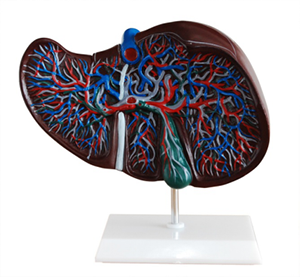Homepageпјҡ NEWS >> Why is the liver anatomical model an important tool in medical teaching?
The liver is the largest substantive organ in the human body, with complex anatomical structure and important physiological functions. However, the anatomical complexity of the liver often confuses medical students and beginners. In order to help students more efficiently understand and master the structure and function of the liver, liver anatomical model as a teaching tool has gradually become an indispensable part of medical education. Why, then, does the liver anatomy model occupy such an important position in medical teaching?
1. Provide an intuitive learning experience
The anatomical structure of liver includes liver lobe, liver lobule, vascular network, bile duct system, etc. These complex anatomical relationships are difficult to show directly in traditional anatomical drawings or books. Through 3D design, the liver anatomical model can accurately restore the anatomical characteristics of the liver, so that students can observe the structural layout and spatial relationship of the liver from different angles. For example, some high-end models can even clearly show the distribution of blood vessels and bile ducts in the hilar area through hierarchical design, helping students quickly understand difficulties.

2. Enhance practical operation ability
Liver anatomy model is not only used in theoretical teaching, but also widely used in surgical training and clinical skills teaching. Through the simulation model, students can practice operations such as liver resection, tumor removal and transplant planning. This hands-on training provides participants with a risk-free learning environment that helps improve their surgical skills and reduces hands-on errors.
3. Improve learning efficiency and memory effect
Research has shown that using models for teaching can significantly improve learning efficiency. A study by a medical education institute in the United States showed that students who used anatomical models to learn about the structure of the liver scored an average of 25 percent better on exams than those who only learned from books. This intuitive way of learning helps students build deeper memories while enhancing their ability to understand and apply knowledge.
4. Data support and industry recognition
Multiple data shows that liver anatomical models have become a standardized teaching tool in medical education worldwide. According to a survey by a medical education equipment supplier, more than 90% of medical education institutions use models in their liver anatomy courses. Some industry experts also point out that as the complexity of liver surgery increases, anatomical models play an increasingly important role in improving the clinical skills of medical students